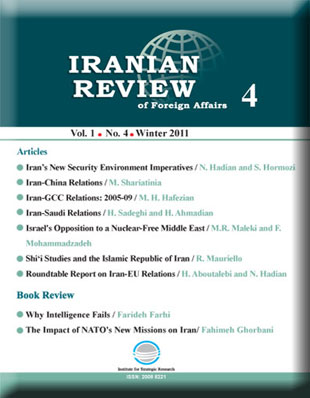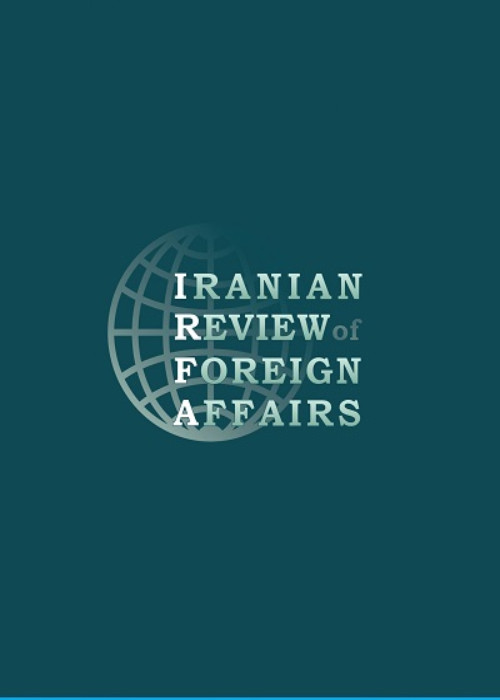فهرست مطالب

Iranian Review of Foreign Affairs
Volume:1 Issue: 4, Winter 2011
- تاریخ انتشار: 1389/12/24
- تعداد عناوین: 10
-
Page 8
-
Page 13The Iran-US relations since 1979 Revolution have remained tension-ridden. Various efforts towards resolution of the sensitive and critical issues between them have failed to bear fruit. The present article looks into the state of these relations from the vantage of Iran’s security environment and how the U.S. policies, particularly since the 2001 occupation of Afghanistan and 2003 war of choice in Iraq, have dramatically affected Iran’s immediate security environment. The paper argues that as a result of the removal of the Taliban and Ba’athist regimes and the emergence of pro-Iran ruling coalitions in Afghanistan and Iraq, Iran’s regional stature and influence was enhanced, which also coincided with simultaneous shrinking of US material and symbolic resources in the region. The article also tries to shed light on the parameters of Iran ''s security environment, decision making processes, sources of security and defense policies, which would help towards a better understanding of the reasons and rationale for the still tumultuous relations with the US, including in particular on Iran’s nuclear program. A review of the past U.S. strategies in dealing with Iran as well as of the alternative strategies currently on the table – Containment, Comprehensive and Selective Engagements, Military option – and Iran’s Counter Containment strategy, indicates that given the actual situation in the region a mere continuation of the past might simply prove impossible. A full-scale confrontation or a major reconciliation appears to be the only possible scenarios for the future. The paper concludes that Comprehensive Engagement will instead present a way out of the decades-old conflict with tremendous benefits for the protagonists and the surrounding region.
-
Page 57Iran-China bilateral relations, established in 1971, have experienced quite substantial change in the post-1979 period, especially since the end of the Cold War. Both countries, despite fundamental differences in ideology and governance structure, and based on a number of areas of commonality, most prominently similar international outlook as developing states of the South, and based on mutual need in economic fields, most notably energy, and also in the military field, chose to expand their relations in various areas. The present article looks into the development of these bilateral relations since early 1980s and discusses two sets of factors that have impacted them; conducive factors and constraining factors. The article argues that while the conducive factors have contributed to the expansion and deepening of Tehran-Beijing relations during the period under review, China’s grand strategy towards becoming a world power and the requisite policy of rapprochement with the West, the U.S. in particular, have in fact intervened to constrain China’s relations with other states – among them, Iran. Simultaneously, perpetuation of a state of tension between Iran and the U.S. in the post-1979 period, and especially since 2003 over the nuclear issue, and hence, U.S. pressure of sorts on China, have also played a critical role in complicating Iran-China relations. China’s support since 2006 for the UN Security Council sanctions resolutions on Iran, despite Iran’s emphasis on the “Look to the East Policy” since 2005, has reflected the Chinese predicament and served to constrain the relations, even to some extent in the energy field. The article concludes that notwithstanding inevitable constraints in Iran-China relations due to the factors involved, both countries will continue to maintain their relations in the economic and energy fields and on international-multilateral issues of mutual interest.
-
Page 87The election of Mahmood Ahmadinejad in Iran in June 2005 came to have an enormous impact on Iran’s foreign relations, including Iran’s relations with the Arab states of the Persian Gulf. The present article looks into the state and dynamism of bilateral relations between Iran and the GCC during the 2005-09 period. Placed in the context of the background of relations between the two sides since the 1979 Islamic Revolution in Iran and specifically the 8 years of confidence-building and détente under Khatami, the article discusses the factors that affected these bilateral relations during the period under review. It is argued that such factors as Ahmadinejad’s peculiar foreign policy outlook and discourse, relations with the U.S., diverging postures towards Israel, threat perceptions, Iran’s rising regional stature and influence in the post-2001 period, and also dispute on the three Iranian islands in the Persian Gulf and the name of the waterway, have each affected the state of relations. The review also shows the resilience of economic and trade ties between the two sides beyond the mere political realm and the outstanding issues and disagreements. Considering the inevitable negative impact of the continuing tension and conflict between Iran and the U.S. on the state of relations between Iran and the GCC, the paper emphasizes the imperative of confidence-building measures and policies by all the parties concerned – within the region and beyond. It concludes that any meaningful improvement – and ultimate rapprochement – in the U.S.-Iran relations, even though far-fetched or illusive at the time, would help these relations and the mutually-beneficial establishment of regional security arrangements in the Persian Gulf.
-
Page 115The 1979 Islamic Revolution in Iran which led to the emergence of a revolutionary, anti-Western, anti-establishment regime under the tutelage of Shi’ite ulema radically changed the previous state of relations with Saudi Arabia, a conservative, Sunnite, pro-West monarchy and junior partner of the defunct Pahlavi State in the security system in the Persian Gulf. The present article intends to look into the state of bilateral relations between the two countries since 1979. The article argues that the relations between these two important Muslim and regional countries have been affected by their constant rivalry in a number of fields considered critical to both of them. As analyzed here, the contest between them in all these areas have been conducted in a rather limited manner, and that both sides have exercised restraint to avoid spiraling into “unlimited contest.” The “limited nature” of contest in fact allowed gradual reduction of tension between them and led to détente and even expansion of cooperation in late 1990s. The détente period came to an abrupt end in the wake of the traumatic aftershocks of 9/11, particularly the U.S. occupation of Iraq. Having looked into the afore-mentioned dominant pattern of relations between Iran and Saudi Arabia since 1979, the authors posit that adoption and pursual of a positive, proactive approach by the two sides and reliance on confidence-building measures can indeed help diffuse the on-going tension and mutual suspicion and pave the way for the promotion of mutually-beneficial policies and measures. In their analysis, the two sides, despite all the differences and difficulties, enjoy the potentials to decide to explore practical ways and means on how to define shared interests, goals and objectives.
-
Page 149Israel began its nuclear weapons program in 1958. Ever since the state of Israel has pursued a consistent policy of nuclear ambiguity, and has amassed over time a huge nuclear arsenal. The United States, as Israel’s strategic ally, and despite some initial misgivings in the early 1960s, has actively supported this policy of nuclear ambiguity. Faced with such a situation, other countries in the region have tried, since 1963, to work towards the establishment of a nuclear- and WMD-free Middle East, which has failed to materialize up to now. The present article looks into the development of the nexus between the Israeli nuclear ambiguity policy and regional efforts towards the establishment of a nuclear- and WMD-free Middle East. The article will discuss the rationale of the Israeli outlook and policy and their implications and repercussions for the countries in the region, and the region at large. The article argues that the Israeli nuclear policy and the categorical refusal to join the NPT have as a matter of fact served as a source of national security threat for others in the region, led some to seek to acquire nuclear capability, and forced arms race on a regional scale. The article concludes that issues of interest and concern to all the parties involved would, in the final analysis, have to be addressed within the context of and in relation to other issues, including in particular, the nexus between regional peace and the nuclear issue. The authors’ final conclusion is that meaningful movement in such a direction will require and depend on the emergence of a realistic outlook on the part of all parties concerned.
-
Page 175Barack Obama’s message to the Iranian people and government on the occasion of Nowruz 1388 (2009) and the appointment of Vali Nasr earlier the same year as Senior Advisor to the US Special Representative for Afghanistan and Pakistan arguably marked a turning point in the US foreign policy vis-àvis the Islamic Republic of Iran and the Shi‘as at large; indicating an enhanced role for Shi‘i Studies in shaping American foreign policy.. However, a number of European and American historians of Islam have endeavored for quite some time to inform both the Western governments and the general public that there is the necessity to distinguish between Islam as an “object” of study within the framework of the history of religions and Islam as a political phenomenon – and therefore as an object of study for the political scientist. The present article, drawing on the writer’s understanding of some implications of a recent work of synthesis about the history of the academic historiography concerning Shi‘i Islam by the Italian Shi‘itologist/historian Biancamaria Scarcia Amoretti (November 2010), addresses the implications of the post-1979 re-interpretation of Shi‘i history in political terms. It argues that in the crisis in the relations between the West and Muslim societies two alternative approaches are conceivable. Either it is assumed that Islam as a religion has little to do with the crisis and that this is the result of geo-politics, political interests, and economic competition among states (Graham 2010), or alternatively, that Islam is in fact the relevant issue at stake, in which case it calls for a serious, scholarly discussion of Islam, primarily as a religion, and hence, a matter of theology and history.


